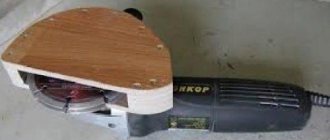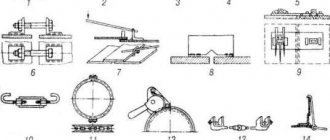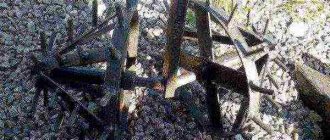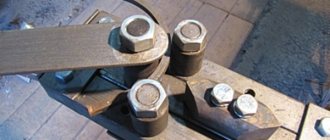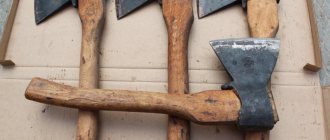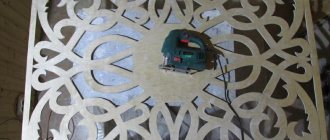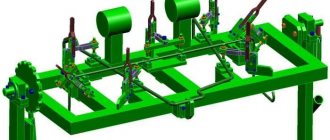Trolleys
Over its rich history, humanity has invented many ingenious devices that greatly simplify life, but the cart is one of the simplest and most effective. Why strain your muscles carrying heavy bags, household appliances, furniture or plumbing fixtures when you can easily move them with this useful tool?
Today there are several types of carts. Each is adapted to specific operating conditions and is used to move various loads. For convenience, each type should be considered, noting the advantages and disadvantages.
Wheeled trolley
The simplest of all, but this is precisely where its genius lies. The design is extremely simple: an axle with mounted rings is attached to a metal frame. For greater convenience, bearings are used. The wheels are equipped with rubber/polyamide tires, which provide good grip on the surface, do not slip, and do not damage the coating.
Wheeled carts are equipped with a handle for easy movement. Their design is worked out in such a way that the loads are distributed evenly throughout the body, preventing physical deformation.
Such trolleys are used to move goods around the warehouse, as well as at the enterprise. They can be used on a construction site.
Trolley levers
An excellent device for loaders that saves effort and time. These trolleys are suitable for moving all kinds of cargo, for example:
- wooden boxes;
- frame structures;
- door panels;
- solid wood.
This trolley is great for quickly moving cargo over a short distance, but does not have additional clamps and stops, and therefore is rarely used when working with a large number of large cargo.
Trolley stands
A simple and convenient device designed for moving loads on a flat surface. The design is a metal frame with several wheels located at different ends. Each chassis has a rotating platform, allowing the stand to move in any direction.
Ladder trolley
It resembles a standard wheeled cart, but has an important advantage - special three-wheeled supports that rotate around an axis. When moving a load on a flat surface, the load falls on two wheels on each side, and the third is located on top. However, when resting on the steps, the axle rotates, throwing the third wheel onto a hill. As a result, this trolley allows you to lift heavy loads to the floor without much effort.
Types of rigging devices and means
The variety of types of loads that need to be moved requires a wide range of rigging equipment for moving loads, designed to make the work of riggers easier, more productive and safer. Rigging equipment is classified in various ways, but the most commonly used system is in which it is divided into:
- rigging equipment - cables, slings, blocks, pulleys, support structures;
- rigging devices – masts, portal lifts, chevres;
- rigging mechanisms - winches, jacks, dollies.
Mounting masts, portal lifts, chevrons are rarely used - during the installation of special large-sized structures, and rigging tools and mechanisms are constantly used by companies specialized in lifting and moving large-sized and heavy cargo. The range of rigging equipment includes:
- steel cables are woven around a hemp or steel core made of galvanized wire, while synthetic cables are made of polyamide, polyester, polyethylene or polypropylene. Rigging cables most often consist of 6 strands twisted around a core impregnated with an anti-corrosion compound that prevents corrosion from getting between and inside the strands when the cable is bent. Current standards classify cables according to more than 10 characteristics, but the main indicators of a cable are diameter and flexibility. The diameter of the cable can be from 1.9 to 27.5 mm, and they are woven from 42 or 144 wires with a diameter of 0.2 to 3.2 mm (accordingly, each strand has 7 or 24 wires). The flexibility of the cable increases with the number of wires;
- slings - pieces of steel or synthetic cable, polyester textile tape, chains connected in a ring or with devices attached to the ends that allow you to quickly and safely secure the load. To connect cables and make loops in the manufacture of slings, clamps and clamps are used to secure stamped or cast thimbles intended for installing a hook, as well as to prevent flattening of the cable and delamination of strands at bend points. Two, four or more lightweight hook and loop slings attached to one eyelet form multi-leg slings. Slings can be self-balancing, semi-automatic, they are used in the manufacture of many types of traverses for rigging;
- pulleys and blocks are used to move and change the direction of the load. Blocks can be single- or multi-role. Single-roller blocks are most often used as outlet blocks and for lifting light loads, while multi-roller blocks are used to lift loads of significant mass. The rollers rotate on an axis fixed to the cheeks, on which the hook and earring are installed. The blocks are equipped with devices that prevent the cable from slipping. The traction force can be reduced using a pulley, consisting of a movable, fixed and retractable block, through which the running cable is connected to a winch, hoist or other mechanism. The running cable can come from both a movable and a fixed block, and the number of threads in the pulley can be both even and odd;
- support structures are required during rigging work with equipment that needs to be raised to a certain height and maintained in this state for some time. In accordance with the mass of the cargo being moved, it can be fixed at the required level using a mounting mast secured with guy ropes, a rigging portal equipped with hoists with a manual or electric drive, and when working with heavy equipment, a steel frame on hydraulic racks is used, capable of lifting and hold the massive load in this position until the design fasteners are installed;
- jacks make it possible to increase the efficiency of rigging operations when lifting loads to a small height. Its main difference is that it is located under the load, which allows you to do without various load-handling devices. The following jacks are used in rigging work:
· hydraulic , converting the pressure of the working fluid into mechanical movement. To do this, after lifting the pump plunger with the lever, the working fluid fills the chamber under it, and when lowering, the plunger increases the pressure in the chamber, opens the check valve, ensuring the flow of working fluid into the container under the piston, which moves upward. Raising and lowering the lever repeats the cycle, extending the rod and lifting the load. The positive properties of hydraulic jacks include:
- high efficiency;
- load capacity up to 200 tons;
- smoothness of rise;
- low applied force;
- compact and stable design.
A hydraulic jack is used in some cases as an independent unit, and in others - as an element of supporting structures and other types of rigging equipment;
· pneumatic, which are inflatable cushions made of reinforced elastomeric or rubber-cord materials, with a load capacity of up to 20 tons. These jacks are distinguished by:
- light weight and minimal thickness in transport position (20 – 25 mm);
- high puncture resistance and abrasion resistance;
- ease of organizing a position for pump installation and operation;
- ease of operation.
Several pneumatic jacks are combined into a single network with a source of compressed air (compressor, compressed air cylinder, factory compressor room), ensuring synchronous operation of all jacks. Low working pressure (from 0.6 to 0.8 MPa) ensures safe work.
· rack and pinion are designed for work in cramped conditions when it is impossible to use electrically driven mechanisms. A rack jack consists of a steel body with a gear rack moving inside it, at the upper end of which a support head for a load is fixed, and at the lower part there is a bent arm used for lifting low-lying loads. The rack moves up and down as the handle rotates, transmitting force to the gear train. On the same shaft with the handle there is a ratchet wheel, resting against the teeth of which a pawl attached to the body fixes the position of the rack. Rack jacks have:
- simplicity of the device and its reliability;
- unpretentiousness when working in difficult conditions;
- smooth lifting of the load to the required height using the handle.
Rack jacks can be used for work in vertical and horizontal positions. They are capable of lifting up to 20 tons on a support and 14 tons on a paw with a lifting height of up to 0.34 m;
· screw, the main element of which is a screw with a trapezoidal thread, rotating in a fixed nut welded into a steel body. At the top, the screw has a square cross-section, where a handle is installed that rotates the screw, and a cup is also hinged to support the load. The handle is equipped with a ratchet (a ratchet wheel with a double-sided pawl), which simplifies the work with the screw jack in cramped conditions. Screw jacks are capable of lifting loads weighing up to 20 tons to a height of up to 0.29 m.
6. Winches are used to move loads horizontally and lift them vertically by rotating the handle in places where the use of specialized rigging equipment is not possible. The handle rotates the spur gears of an open two-stage gear train or a worm pair with a friction brake. Hand winches:
- able to work in any direction;
- reliably protected from overload;
- work with a cable of any length.
An electric drive and replacing the brake with a shoe or disc brake with a safety clutch turns a manual winch into an electric one.
Lifting straps
This is perhaps the most ingenious device of all presented in this rating. Lifting belts have several important features:
- a huge margin of safety, thanks to which they perfectly withstand enormous loads;
- complex, dense weaving - the belts do not twist, compress, or stretch when moving loads;
- optimal width - they do not dig into the skin and do not squeeze the blood flow, allowing you to work with loads much longer and more comfortably;
- versatility - the design is designed in such a way that carabiners and additional accessories can be attached to them.
Lifting straps come in various types. On sale you can find models for forearms and shoulders. It is worth considering the features of each model.
On the forearm
As the name suggests, these belts are placed over the forearms. This eliminates the need to hold the load with your fingers and hands. The disadvantage is that the biceps and a number of other muscles remain involved, and therefore these belts are more suitable for men of strong physique.
On shoulders
This model has a similar design, but the loops are placed over the shoulders, while the sling is fixed on the torso. As a result, the hands are not involved in lifting heavy objects (it is enough to hold the load while carrying it). The entire load falls on the legs. The back also remains unused, which eliminates damage to the lumbar region and spinal column. As a result, these belts are suitable even for women.
Rigging work
Any operations related to moving, holding, lifting or lowering various types of objects - equipment, accessories, components, machinery, etc. - relate to rigging work. Their fundamental difference from traditional loading and unloading operations is the use of special equipment that facilitates the performance of the listed operations.
Often technical devices have an unusual configuration. Their use is based on the impossibility of performing work in any other way. That is, without such equipment, workers will not be able to move, lift or lower the load. The cost and timing of contracted services are determined by the nature of the cargo and the complexity of the operations.
Transport handles for plasterboard, plywood, chipboard, OSB
The genius of these devices cannot be overestimated, because the main character is physics itself. The transport handles are designed in such a way that when lifting a load, the center of gravity shifts, thanks to which the design hooks reliably hold sheet materials, preventing them from slipping out of your hands.
Handles are ideal for handling all kinds of sheet materials:
- large pieces of plywood;
- drywall;
- glass
These devices protect your hands from damage, preventing your skin from getting splintered on the edges of wooden materials or cut on the sharp edges of sheet glass. They provide not only grip, but also carrying.
There are friction models of transport handles that are excellent for working with particularly heavy and large loads. Due to their simplicity, these devices are often used in professional environments.
Machines for loaders
The machines are a complex device equipped with a metal frame for installing/holding the load, as well as a sling, belts and fastenings that are fixed on the loader’s back. Thanks to their well-thought-out design, the machines are suitable for moving loads weighing up to 50 kilograms, and thanks to the flat frame, they eliminate the load on the spine and lumbar region. When carrying heavy loads, the entire torso works, and the main load falls on the shoulders and legs. Thanks to a special belt system, the machines easily adapt to the worker’s body type, allowing you to work with maximum comfort.
Exoskeletons
An innovative invention designed for builders and warehouse workers. Its disadvantage is its high cost, since the exoskeleton is a complex technical device. It is controlled by a person, repeating the movement of the silhouette, but at the same time takes on the main loads. As a result, this device not only supports the back, eliminating injury, but also greatly increases muscle strength, allowing even an untrained person to work with heavy loads. Power is provided by built-in rechargeable batteries.
Support structures
Sometimes situations arise when a load needs to be lifted and held in this position for a certain period of time. Support elements that can withstand heavy loads are required. Most of them are a vertical metal support with guy wires. At its lower part there is a massive concrete slab as a support.
If the object being lifted is relatively light in weight, then a hoist can be used. When working indoors, they are fixed to ceilings or other durable building structures.
Jacks and jacks
Here we are talking about special devices, mostly used in enterprises and large warehouse complexes. The design of the jack is known to any motorist. Thanks to its special design, this device can lift heavy loads while holding them suspended.
Professional jacks have undergone a number of technical changes, due to which they are used to move heavy loads. They help hold various materials at a low height, but this is enough for movement.
Rokhlya is a fork cart, a hybrid of a wheeled cart and a jack. In appearance, they resemble the working forks of forklifts, and the name comes from the name of the company Rocla, which was one of the first to supply trolleys to the USSR.
It is a hand-held device primarily used for lifting and moving loaded pallets and drums. Thanks to the metal body and special chassis, they can withstand heavy weight, and a handle connected to a jack mechanism is used to control when moving the load.
Types of rigging work
Classification of rigging work is carried out according to various criteria, incl. and according to their complexity:
- simple, allowing you to do without the use of specialized equipment;
- medium complexity – moving cargo weighing up to 20 tons using manual rigging equipment;
- complex, requiring the movement of heavy and oversized cargo weighing more than 50 tons using various types of equipment and various rigging technologies.
Moscow-St. Petersburg will produce within the agreed time frame and with high quality:
- relocation of a manufacturing plant;
- delivery of heavy and/or oversized cargo;
- installation and dismantling of technological equipment;
- loading and unloading operations with cargo of any weight and size;
- lifting heavy and/or oversized cargo to heights.
Our employees have the knowledge, skills and experience to perform rigging work of any complexity!
Transport kits
Here we are talking about heavy-duty stands of various sizes and shapes that easily connect to the handles. They are suitable for two categories of consumers:
- professional loaders who work with heavy materials day after day;
- new settlers who needed to transport personal belongings to a new place of residence.
Their low cost makes transportation kits accessible to a wide range of customers, and besides, they do not require special handling skills.
Other meanings of this word:
- “Reinforced concrete” Russian poet
- “Reinforced concrete” Russian poet.
- "Poet" used in technology
- "boosting..." of a rocket
- "Scythians"
- Author of the poem "The Twelve"
- Author of the poem "Scythians"
- Actress, ballet historian, author of the book of memoirs “Both true stories and fables about Blok and about myself” and the fundamental study “Classical dance”. (surname)
- Alexander (1880-1921) Russian poet, drama “Balaganchik”, play “Rose and Cross”, cycle “Iambics”, poem “Retribution”, poem “Twelve”
- Blocking an athlete during a strike or throw
- William (1845–1926) was a Danish writer and theater director. In 1872 he made a two-month trip through Germany, Austria and Italy together with H. C. Andersen;
- Volleyball defense
- volleyball move
- lifting device
- Ten packs of cigarettes
- part in the form of a wheel with a groove around the circumference for thread, chain, rope
- Jean Richard (1884-1947) French writer and public figure, participant in “Clarte”, the books “... and Sibylle”, the drama “Toulon”
- Volleyball defense
- volleyball defense or Russian poet
- defense in karate
- Kickboxing defense
- A defensive technique in sports games with a ball, which consists of blocking the path of the opponent’s ball or a player of the opposing team
- son-in-law of Mendeleev
- famous Russian poet Alexander
- The famous Russian poet Alexander...
- When despair and anger die down, sleep descends. And we both sleep soundly at different poles of the Earth. - author
- structural assembly or product
- Structural element of a building
- A structural element of a building used in modern industrial construction as a finished part of the structure
- who in Akhmatova’s poems “accepted mortal languor as undeserved peace”
- who in Akhmatova’s poems “accepted mortal languor as undeserved peace”?
- Who wrote the poem "Ecclesiastes"
- Marc (1886-1944) French historian, together with L. Febvre founded the magazine “Annal...”
- Small nicotine wholesale
- Mechanism, structure, set, etc., consisting of several homogeneous parts
- NATO as a building block
- Uniting states, public organizations or groups for joint action
- Association of Politicians
- He wrote: “Erase random features and you will see: the world is beautiful”
- Party core in the Supreme Council
- The party core in the Supreme Council.
- A slab of natural or artificial stone of a certain size and shape (in construction)
- lifting device and at the same time a famous Russian poet
- Poet ("Twelve")
- poet of the silver age
- Poet, author of the poem "Twelve
- Martial arts technique
- Reception in volleyball
- Defense technique in volleyball
- Defense technique in sports
- Hand-to-hand combat technique to repel an enemy strike
- A device in the form of a wheel with a groove around its circumference, through which a rope, rope, chain, etc. is thrown, intended for lifting heavy objects
- A device for lifting weights, consisting of a wheel with a fixed axle, with a groove around its circumference and a rope or other flexible rod thrown through it
- A device, usually equipped with a spring, that serves to tightly close the front door
- type of packaging for goods
- Russian poet (1880-1921, 'Twelve')
- Russian poet or “workshop” at a nuclear power plant
- Russian poet or 10 packs of cigarettes
- Russian poet or ten packs of cigarettes
- Russian poet or builds. element
- Russian poet with a technical surname
- Russian poet with “builds.” last name
- Russian poet, author of the poem “The Twelve”
- Russian poet, author of the poem "Scythians"
- Russian poet, author of the cycles “Faina”, “Carmen”, “Motherland”, “Crossroads”
- Russian poet, author of the cycles “Iambics”, “City”, “Mask”, “Snow”
- Russian poet who dedicated beautiful poems to a stranger
- Russian poet, poem “The Twelve”
- Russian poet; package; weight lifting mechanism
- System... at the computer
- adjacent part, unit
- Agreement, association of states, parties, organizations
- An agreement providing for joint action to achieve common goals, alliance
- mechanism parts assembly
- Pack of ten packs of cigarettes
- pack of ten packs of cigarettes
- Impact protection form
- French historian of Jewish origin, author of works on Western European feudalism, agrarian relations in France, general problems of historical methodology
- French writer (1884-1947, 'Sibilla', 'Spain! Spain!', 'Toulon')
- French writer, playwright, public and theater activist, anti-fascist. (surname)
- internal combustion engine part
- Part of the lifting mechanism in the form of a wheel with a groove around the circumference for the cable
- Part of a structure or mechanism
- Part of a technical device, instrument, etc., consisting of many elements and intended to perform a specific technical task
- part of a device, mechanism, instrument
- A pulley or several pulleys in a cage for passing cables and fastening
- pulley, Russian poet and NATO
- pulley, Russian poet or NATO
- economic...government
Clamp for carrying bricks and stones
This simple device is a metal frame that allows you to securely hold piece goods and building materials. Using a clamp you can carry:
- bricks;
- natural/artificial stone;
- various building materials.
In fact, the clamp is a handle that allows you to combine several bricks into a single block, while it firmly fixes them, preventing them from falling out while being carried.
Slings and jacks
The devices are short ropes of various configurations. They can be electronic or manual, and are used directly during loading and unloading operations. The maximum lifting height in this case is 3 meters. The maximum permissible weight of cargo that can be lifted using slings is 10 tons.
If you need to lift a heavy load to a small height, then jacks are used. They differ in lifting methods and are mechanical, hydraulic, pneumatic; screw, wedge or rack.
Suction cup for carrying glass
Last but not least, this device will be indispensable for those who constantly work with sheet glass. The suction cup provides a strong hold due to the vacuum effect, and thanks to its elastic surface it does not damage the glass, does not leave scratches or chips. There are both mechanical and electronic suction cups. The latter are used mostly in the professional sphere.
This concludes our review of ingenious devices for carrying heavy loads. Now, when preparing for a move, renovation or construction work, you can choose the right option and keep your back healthy. Take care of yourself and feel free to use these incredibly useful devices.




